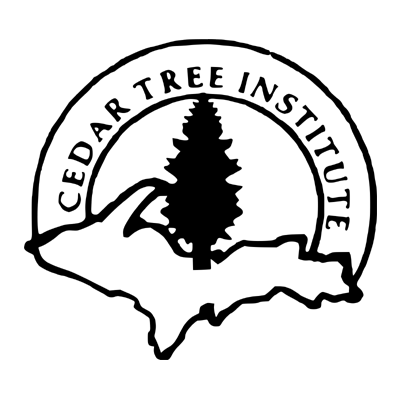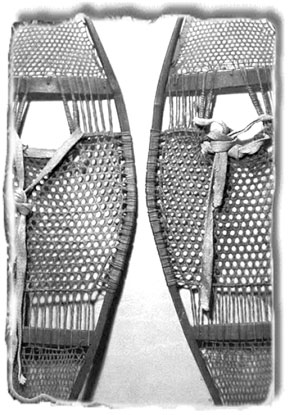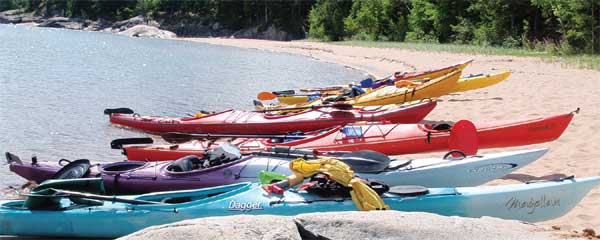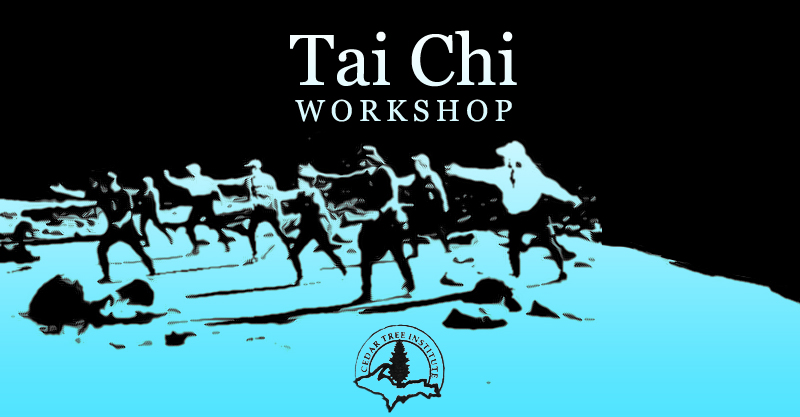from Marquette Monthly December, 2006
The life and legacy of Frederick Baraga
Mounted on a closet door in my home office is a pair of hemlock-framed, leather-bound snowshoes. They’re more than thirty years old, purchased during my first winter serving as a parish pastor in Mackinac County. I was assured this particular style of snowshoe, made in Shingleton by the Iverson family, was used by the most experienced loggers, trappers and hunters in the Upper Midwest. There’s not a finer example of craftsmanship and durability.
In coming winter days, a younger generation of outdoor enthusiasts will trudge their way across Marquette County’s backcountry snow for recreational snowshoeing. Chances are, after an hour or two, they’ll find their way to a local coffee shop to console each other about weary legs, cold wind and the glare of sun off ice and snow. Most will be unaware they follow in the footsteps of a remarkable nineteenth century priest Frederic Baraga, who worked among the Ojibway and Ottawa Indian peoples of Northern Michigan.
As part of his regular mission responsibilities, Baraga routinely snowshoed 600 to 800 miles a winter across this same rugged landscape in weather conditions most of us would find unbearable. Most often he traveled, it’s reported, with a Native companion. Strapped across his shoulders he carried a worn backpack with a few rations, a bedroll, a chalice, his vestments and a prayer book.
Every priest and clergy serving in the North Country, Catholic or Protestant, can only be humbled by the sheer force of his courage, humility and stamina. The well-known nineteenth century geographer Johann Georg Kohl, after traveling across the Keweenaw Peninsula on foot with Baraga in 1856, called him “a man of iron.” He was that, and much more.
Modest, intense, mysterious and controversial, as a young man he walked away from an inheritance and a life of privilege in Europe. Throughout his life as a priest and bishop, he consistently avoided any hint of special privilege. He requested, more than once, to sleep on a wooden floor. Baraga wrote prolifically, yet documents confirm that he cared little for public recognition. Shortly after his appointment as bishop, he was required to travel to Baltimore for ecclesiastical business. During his visit there in 1866, Orestes Brownson, one of the great intellects in the church of that time, described Baraga as “smelling like an Indian.”
There’s plenty of evidence to suggest that the “snowshoe priest,” as Baraga came to be known, considered that an honor. He held little if any interest in elaborate tributes regarding his priestly vocation. Arriving in Marquette in 1853 to begin work in his new role as administrator of the Roman Catholic Diocese of Sault Ste. Marie and Marquette, he requested adamantly there be no special gathering or welcoming celebration.
There’s a light rain falling. I’m sitting at the dining room table of a modest home, nestled in groves of pine and spruce trees not far from Lake Superior’s shoreline. My host is the former archivist of the Bishop Baraga Association; we’re sharing a simple meal of soup and bread. Two cats slumber at our feet.
A former teacher of Latin, history and theology in Catholic schools, my colleague is a faithful, insightful participant of a weekly text study for area church leaders that I make a regular effort to attend. She’s also the primary editor for the Diary of Bishop Frederick Baraga, first published by Wayne State University Press in 1990.
Facts of Baraga’s personal and professional life (1797-1868) are well documented. I’ve come to probe the more elusive, complex aspects of this revered, heroic figure. As a researcher and long-time student of Baraga’s writings (singularly responsible for the meticulous annotations for the translations of Baraga’s journal entries), she pauses, then offers helpful reflections.
She believes Frederic Baraga was a lonely man. His childhood in Slovenia was marked by the deaths of both his mother and father. This experience of emotional abandonment likely shaped Baraga’s spiritual sensibility.
It was a wound that probably never healed completely. His sister remembered him as an adept artist, skilled in handwriting and painting. Later, in letters written from America, Baraga wrote about a fondness during his boyhood for walking tightropes, enabling him to cross over logs bridging rushing brooks and streams. In law school, he became engaged to one of his professor’s daughters. Decisions to break his engagement, walk away from his inheritance and enter the ministry entailed deep, private struggles. He spoke and wrote nothing of these personal matters. To this day, they remain masked under a veil of mystery.
What we know for certain is that first as a student and then as a young priest, he was influenced by Father Clement Hofbauer, a charismatic reformer in the Catholic Church. Hofbauer felt deeply about sharing the Gospel message of love and self-dignity with the poor and abandoned. These beliefs reinforced Baraga’s personal lifestyle choices of modesty, prayer and self-discipline. In Slovenia, Baraga began to write and edit devotional books for the common person. The most famous of these, Dusha Pasha (Pasture for Souls), is still in print.
Baraga committed himself to a Christian message that invited simplicity instead of display, discipline instead of indulgence, denial instead of sensuality. The importance of prayers and lessons in the Mass being offered in the common language of people became a core conviction. In this historical perspective, one better understands why he was so fiercely committed to Native peoples retaining their own language—a position viewed by both liberal government and most Protestant missionary efforts as being regressive and ignorant at that time.
According to written records, Baraga physically was a man about five-foot four and 150 pounds. He wore his hair long, had rather short legs and usually spoke in a cool, measured tone. Baraga carried himself with dignity. He enjoyed casual conversation and was an appreciated companion. He had a reluctance to travel by boat or ship. We know, too, he was an individual of tremendous energy. His dedication to visiting the sick to bring sacraments and prayers is legendary. It was not unusual that he’d embark on winter trips of over fifty miles by snowshoe to pray by the side of a single family. He could, at the same time, become unexpectedly irritated under certain circumstances. He appeared to be strong-willed, but emotionally sensitive. During sermons he would, on occasion, shed tears.
At the age of forty-four, Baraga moved into deeper spiritual discipline and committed himself to a life of prayer, arising daily at 3:00 a.m. to pray for two to three hours. He was extremely generous, from some perspectives, to a fault. Material goods appeared to mean little to him. For the most part, he was suspicious of government matters. He never voted. He was known by colleagues to carry a mistrust for authorities, most likely reinforced by his experiences with federal policies involving the Natives he served.
My colleague and I talk at some length about the depth of spirituality that leads individuals, vulnerable and often lonely, to achieve unusual ends and make remarkable sacrifices. References to writings of Thomas Merton and Henri Nouwen punctuate our conversation. Before leaving, I’m given a tour of a neat, organized library tucked away in a basement office where this former archivist continues to write her monthly column for the U.P. Catholic newspaper. Approaching the door, I catch a glimpse of a framed sketch of a young man, strangely familiar. “Stanley Rother,” she says. “A Diocesan priest from Oklahoma City, killed in 1981 in Guatemala.”
Mention of the incident sparks my memory. At the time, his untimely death attracted attention from both church and secular media across North America. While working on behalf of the poor, Rother was murdered by what now has been confirmed as U.S. government-supported assassins. I’d heard of his work in Central America at a pastoral conference. Following his death, members of the Guatemalan farming community where he lived and worked began to weave and distribute liturgical stoles to support their rural village economy. One of those stoles is numbered among my first liturgical vestments. I made the purchase in Chicago for a modest contribution, sent to the village in his honor. Baraga’s work among the missions, for which he is best known, followed the long involvement of the Jesuits in North America. Between 1611 and 1764 more than 300 Jesuit priests traveled from France to North America to establish what came to be called the “forest roaming church.” Known as “Black robes” to many Natives, their explorations and travels led them from the eastern coast of Canada, north to Labrador and the Hudson Bay region, west to the Great Lakes and Wisconsin, through the prairies of Illinois and south, down the Mississippi to New Orleans.
The Jesuit legacy as missionaries among America’s Native people, still idealized by many followers of Catholicism, is now viewed by many historians as a darker, more complex mix of cross-cultural conflict, ethnocentrism and misplaced zeal. Frederic Baraga, although remarkable in devotion, still was, as we all are, a product of our times. Given that, there’s evidence Baraga should be regarded with even deeper respect than one might suspect.
Among his best-known achievements was the compilation of the first Ojibway dictionary (Grammar and Dictionary of the Chippewa Language) in 1853. Trained as a linguist, Baraga had the skill to carry through this unusual, formidable task. His dedication to protect Native languages ranks among his most admirable accomplishments. What’s not widely known by the general public were his controversial efforts to keep Native groups from being removed to the West during his first mission experience in Grand Rapids.
In the early nineteenth century, United States Federal Indian policy was shaped primarily by economic interests to expand and develop the Northwest Territories (what is now Michigan, Wisconsin and Minnesota). During the first years as a mission priest among the Ottawa, Baraga was an outspoken defender of the right for Native peoples to live on their traditional lands. For his efforts, he was marginalized by Federal authorities, eager land developers and some church officials. Most were seeking, for their own interests, approval from a New World’s emerging political leaders.
Baraga carried this same ongoing conviction to his work at the LaPointe Mission (in the Apostle Islands) from 1835-43, then to the mission at L’Anse (1843-53).
In a striking example of interfaith cooperation, the local Methodist missionary in L’Anse, John Pitezel, joined with Baraga to have both churches purchase property from the government, then deed it back to the Ojibway. This quiet act of political maneuvering is now regarded by historians as a key element in the formation of the Keweenaw Bay Indian Community and the establishment of the reservation that exists there today. Baraga was ostracized for these actions publicly and privately by both government and church leaders who had other competing visions managing what in the nineteenth century was known as “the Indian Problem.”
Baraga, to be sure, was not exempt from the shadow side of human missionary efforts. To assume differently would be to deny the truth about him as well as our own cultural and ethnic biases. On the journey across the Keweenaw Peninsula cited earlier, Kohl, the geographer, writes that once he tried to open a conversation with Baraga about the Mediwiwin, the traditional Ojibway religious tradition. He reported Baraga casually dismissed his inquiry, showing no interest.
The Mediwiwin never received the respect it deserved. This is something that Christians need to acknowledge and for which contemporary church leaders need to ask forgiveness. Bitterness is buried deep within hearts of many traditional Native people regarding over-aggressive missionary efforts. I’ve been told by Native people here in Northern Michigan that there are rituals practiced with prayers and ceremonies that are used, even now, to remove the sign of the Christian cross once granted at baptism. But there is a missing piece of the story worth telling.
Several years ago, while teaching with NMU’s Department of Native American Studies, I went on a field trip to one of our Upper Peninsula’s American Indian reservations. In response to a question about how Native religious teachings might be recovered, one of the elders of the Mediwiwin replied, “Tell the truth about Bishop Baraga and his journals.”
Puzzled, I asked him to explain. He told us that among the oral tradition of the Mediwiwin, there is a story that later in his life Baraga not only attended Native ceremonies and prayed with the Ojibway, but asked to be initiated into the “way of the dream.” There is, in fact, at least one of Baraga’s journals after 1863 that has never been found. Whether Baraga ever explored the Native spiritual world in a more humble, respectful manner will never be known. But a small group of Native traditionalists continue to believe he did.
Among the public, especially among our region’s faithful Catholics, it’s known that Baraga’s remains are interred in a crypt under the Chapel of the Blessed Sacrament in Marquette’s St. Peter Cathedral.
It’s early evening and I am making my own visit for the first time. A side door on the Cathedral’s East side offers access to a stairwell leading into the basement and burial vault area. A modest, relatively small sacred space, it’s simply but reverently lighted.
The remains of Baraga and five succeeding bishops are interred there, each in separate vaults. Over Baraga’s vault there are several prayer cards with hand-written messages carefully slipped under the edge of a framed painted portrait of the first bishop of the diocese.
The circumstances of Baraga’s death reflect his commitment to the mission that so enveloped his energy and spirit. While in Baltimore for the Second Plenary Council of Bishops in 1866, he was struck with a series of strokes. He quietly left with his colleague, Fr. Honore Bourion, to return to the Upper Peninsula, knowing that others would try to persuade him to stay in that urban area where there would be better medical assistance.
The trip north by train was difficult. Bourion needed to literally carry Baraga in his arms as they changed train connections.
Arriving back in Marquette, Baraga’s health declined at a steady pace. For the last year of his life, his body racked with palsy, he was unable to stand at an altar to administer the sacraments. During those years, the struggling diocese was under stress from limited finances and demands of creditors. To the end, the Bishop administered his responsibilities as best he could from his bed. Shortly before he died, he gave the last of his own money ($20) to a priest, Fr. Gerhard Terhorst, who was struggling to keep the American Indian school open in L’Anse. Baraga died penniless. Because of weather and travel, only six priests attended his funeral. No other bishops were in attendance.
In my coat pocket is a green twig from the forest, one of four “medicines” traditional Ojibway peoples use for ceremonial purposes. I’ve come now to pay my own tribute to the snowshoe priest. Dropping to one knee, I bow my head, gently laying a handful of cedar on the small altar.
To you, Frederick Baraga, faithful servant and priest, our thanks. And homage to that spirit—deep, loving, personal—who long ago carried you across hundreds of miles on snow-covered trails under cold December moons; who led Stanley Rother from Oklahoma City into a life with the poor in Guatemala; who still quietly sustains those who do the unsung work of compassion and justice among us; who blesses followers of the Mediwiwin in their night dreams…To that Great Mystery, be all Glory and Honor.
– Jon Magnuson
December 2006




